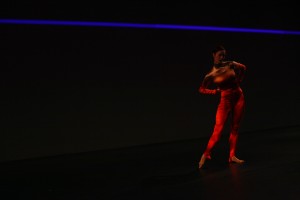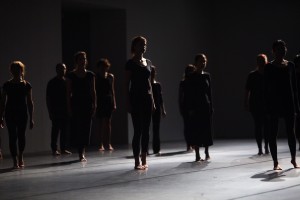A very large fourth floor gallery space was emptied out for Michael Clark’s Who’s Zoo? at the Whitney Biennial (April 7, 2012) in order to look and feel like a performance space. The audience was directed to sit on the floor at one side of the gallery all for the forty-minute show. The performing area was extremely wide although not comparably deep, and was symmetrically framed by two entranceways at either side serving as wings for the performers. Charles Atlas’s lighting and video projections for Clark on the back wall would create a sense of depth for the choreography as the piece progressed, which from the start privileged the use of diagonals for very practical reasons. The space used in this way was far from ideal as the intimacy of viewing dance in a museum was undermined by the lack of space in depth and hence of perspective. The performance style of the dancers, in addition, seemed more inclined to projection to an audience further away. Despite this impediment, the visual qualities of the space were extremely “clean”. A laser-like lavender line cut horizontally across the white wall we faced, joining the two entranceways.

The walls were white, the marly floor was black; copious lights hung unobtrusively from the ceiling, which was high enough to render the technical apparatus virtually invisible, as in most theaters. In short, I was not terribly aware I was in a museum except for the challenge of crowd management briefly imposed on museum staff.
Clark’s company boasts six excellent dancers and himself. Three men and three women appeared initially as two species – two men in black leotards and the other four dancers in glowing orange. The music initially made this feel like a late sixties so-bad-it’s-good sci-fi film. The choreography seemed derivative of Cunningham although Clark injects arresting torso shifts that project a sensuality into the classical figures. Later on, all six sport stylish zebra like leotards. It would seem Clark is presenting his performers as dancing creatures – hence the zoo. Or, perhaps, he is saying dance always already takes place in/as an atrophied museum of its own fashioning. Clark’s own presence offered a useful counterpoint as he hovered on the outskirts in pedestrian garb fulfilling his reputation as the bad-boy of British contemporary dance.
The two male dancers in black worked in rhythmic unison, occasionally partnering each other. In fact, most of the choreography mimicked the musical rhythms. The title Who’s Zoo? suggested the dancers were creatures to be observed in their habitat and introduced in this way a sense, perhaps, of the natural history museum. Some kind of critique of the museum was being suggested here, doubtless, but it lacked focus. The title’s question also suggested the reading: Who is Who? – which could be understood to ask: Who is the audience and who the performer? Or, who is the human and who the animal? Understanding the question this way was underlined by the participation of many amateur dancers — called “untrained volunteers” in the program — Clark used in counterpoint to his professional and highly trained company. The program stated somewhat naively this was “an attempt to expand what our experience of movement can be.” One could, however, consider the untrained volunteers to be the third species on stage, one with which the audience might identify as the amateurs coped with their fairly basic rhythmic unison assignment.

In the final section, a vocalist in green face paint and blue jeans took center stage to underline a grotesque presence hinted at marginally by Clark from the start. The performance from here on devolved into an acid rock concert as Darren Spooner bleated “Maggot Brain” deafeningly into a mike and any notion of choreography faded from view. This gesture in conjunction with the sci-fi ambiance, and the unfocused critique lent a dated feel to the proceedings. The sci-fi parody blunts the museum critique and leaves us wondering what is going on. Does dance in the museum need to acknowledge the institutional site of its performance? Or, should it transform the museum into a theater? Neither of these tendencies were realized by this performance, but both remained as unresolved questions.
A few days later I attended the conference “Making Time: Art Across Gallery, Screen and Stage” at UC Berkeley’s Arts Research Center. Here were assembled a group of artists, curators and academics to discuss the presence of time-based art in museums. I was honored to be on a panel to discuss “Dancing in the Museum.” with Jonah Bokaer, Judy Hussie-Taylor of the Danspace Project, and Ralph Lemon. (The entire conference will soon be available on line at: arts.berkeley.edu). Sabine Breitwieser, curator of Media and Performance Art at MoMA, expressed the view that dance now finds itself in the museum because dancing bodies display skills and are attractive to look at. Shannon Jackson, director of the Arts Research Center, assured the audience in introducing our panel that we would make the deceptively simple “dancing in the museum” scenario more complicated.
The fields of visual art creation and the curation of art, film, dance and theater were well represented at this conference through an interdisciplinary discussion where no one discourse dominated the conversation. I noted that some curators are aware dance brings the public into the museum. Choreographers and companies are aware that museums are the new performance producers on the block with a big budget. The question of the museum as a site of display in which moving bodies challenge previous definitions of what it means to exhibit art objects and material culture was stimulating. This is uncharted territory. Curators seem to be anxious to learn more about dance and its histories; artists are aware that time-based models of art in some ways contradict the institutional mandate to preserve and display art; scholars are examining notions of liveness and objecthood in relation to exhibition and performance.
You must be kidding!